Papers by Assoc Professor Himanshu Shee
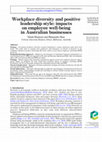
Leadership & Organization Development Journal, 2024
Purpose-Increasing workforce diversity requires leadership to ensure employees retain their wellb... more Purpose-Increasing workforce diversity requires leadership to ensure employees retain their wellbeing. This study aims to examine how employees' and managers' co-creation of diversity in the workplace influences positive leadership (PL) style, which in turn affects employee well-being (EWB) positively. Design/methodology/approach-Employees and managers of Australian businesses participated in a cross-sectional survey. EWB was regressed on PL style and diversity dimensions (DDs). Also, the mediation effect of PL style between DDs and EWB was tested. Findings-Results suggest that Australian organisations appear to have more employee diversity with its partial impact on managers' PL style, which then positively affects on employee well-being (EWB). Furthermore, the PL style partially mediated the relationship between DDs and EWB. Practical implications-Managers will better understand workplace diversities and the key role that PL style can play in enhancing EWB. Social implications-This study will help improve employees' and managers' personal and social lives by developing a better understanding of health and well-being. It will have further economic impacts, such as higher organisational productivity. Originality/value-This study fills the gap in the literature where PL style will positively affect EWB. Investigating the relationship between DDs, PL style and EWB using PERMA-profiler is a unique contribution.
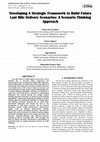
Operations and supply chain management : an international journal, Mar 26, 2024
Last mile delivery (LMD) logistics research has drawn attention due to increased urban compactnes... more Last mile delivery (LMD) logistics research has drawn attention due to increased urban compactness and environmental concerns arising from freight traffic congestion. This has affected the cost-effectiveness and on-time delivery of urban freight. This study aims to develop a strategic framework to formulate future LMD scenarios based on transport and urban planning constraints using a scenario thinking approach. A scenario thinking stakeholder workshop was conducted to collect data on last mile delivery constraints in Metropolitan Melbourne. The research develops five abridge scenario thinking stages that researchers can adopt in scenario thinking methodology. Using brainstorming and storytelling of scenario thinking approach, participants identified 34 transportation and planning constraints clustered into six urban builtenvironment dimensions that formed the basis of the development of LMD future scenarios. The six clustered dimensions include Freight Infrastructure, Infrastructure Supply, Land use Intensity, Infrastructure Sharing, Intersection Controls and Human Behaviour. Infrastructure Supply and Land use Intensity were found to represent higher uncertainty and higher impact on city logistics provisions. The proposed regulatory-informed and efficiency-responsive strategies are the key to manage LMD. These strategies will help city logistics providers and planners in development of operational plans in making investment decision on LMD challenges.

Proceedings - Academy of Management, 2015
Logisticians in the field of freight movement and transportation have argued for 'sustainable... more Logisticians in the field of freight movement and transportation have argued for 'sustainable freight distribution' through triple bottom line approach. Potential solutions identified are co-opetition, freight consolidation and collaborative freight distribution which appear to have limited academic investigation of their influence on sustainability. This paper investigates this gap in current sustainable freight distribution literature. Measures of coopetition, freight consolidation, collaborative freight distribution, and sustainable distribution were embodied in a survey distributed to newspaper firms, transporters and newsagents in context of Thailand. Structural equation modeling (SEM) was employed to test the hypothesized relationships. Results show that firms who perceive to leverage co-opetition, freight consolidation and collaborative freight distribution approach will achieve a significant sustainable logistics distribution. Managerial initiatives should be directed at developing co-opetition and freight consolidation strategies and leveraging it for a collaborative freight distribution that can lead to sustainable distribution in supply chain.
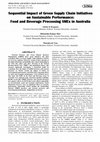
Operations and Supply Chain Management: An International Journal
External Pressure and Green Human Resource Management (GHRM) drive green initiatives but their sy... more External Pressure and Green Human Resource Management (GHRM) drive green initiatives but their synergistic effects on Green Supply Chain Initiatives (GSCIs) are yet to be explored. Moreover, results of three elements of the triple bottom line sustainability show mixed relationship in the order they affect each other. Drawing on the Natural Resource-Based View (NRBV) and institutional theory, this research empirically investigates a theoretical model by examining: first, the impact of GHRM practices and external pressures on GSCIs; second, the impact of GSCIs on environmental performance; and third, their sequential effects on social and economic performance. Cross-sectional survey data from 168 SMEs in the Food and Beverage sector in Australia were analysed using structural equation modeling. Results reveal that GHRM practices and external pressures have positive effects on GSCIs that in turn affects sequentially on environmental, social and economic performance. Social dimensions, however, have no significant effect on economic performance. Meanwhile, GSCIs mediate the relationships between GHRM practices and external pressures and environmental performance. Implications are drawn.
The Palgrave Handbook of Supply Chain Management

Operations and Supply Chain Management: An International Journal
Drawing on Resource Dependence Theory (RDT), the objective of this study is to empirically explor... more Drawing on Resource Dependence Theory (RDT), the objective of this study is to empirically explore supply chain disruptions of COVID-19, and suggest strategies to mitigate them. In-depth interviews were conducted with supply chain professionals working in the Electrical & Electronic (E&E) industry in Malaysia. Interviews were analysed by following seven steps of the van Kaam method. Findings suggest six strategies: global command centre with daily planning cycle to mitigate component shortages; collaboration with suppliers to mitigate glove shortages; assist local suppliers in obtaining permits to mitigate disrupted manufacturing; dual sourcing to mitigate single-sourcing disruptions; collaboration with freight carriers and government agencies to mitigate disrupted freight; and ERP-integrated EDI to mitigate disrupted data sharing. The findings offer strategies for managers to de-risk their supply chains in post-COVID-19 era, and it could be applied further in similar future supply chain disruptions.
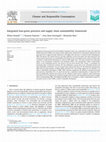
Cleaner and Responsible consumption, 2023
Integration of lean-green practices has benefited companies in many ways, particularly the large ... more Integration of lean-green practices has benefited companies in many ways, particularly the large ones. Small and Medium Enterprises (SMEs), as key players within supply chains, should also be encouraged to apply the lean and green practices to support the large enterprises in the supply chain. However, it remains all time challenging for SMEs that operate with limited resources, and often emphasize on short-term goals with rapid turnaround. The impact of green-lean practices on sustainability performance has been investigated earlier, however further study is needed to understand the phenomena in context of SME supply chain. This study examined the moderating effects of top management commitment and leadership (TMCL) and organizational culture transformation (OCTr) on the relationship between Lean Practice (LP) and Green Practice (GP). Further, it investigated the moderating effect of both policy initiative (PI) and collaborative synergy (CS) on the relationship between GP and sustainability performance. The survey-based study analyzed the data from 345 Indonesian manufacturing SMEs using structural equation modeling (SEM) with Smart-PLS. The findings suggest that GP mediates LP to improve sustainability performance of SMEs. TMCL facilitates significantly the adoption of integrated lean and green practices. Meanwhile, OCTr, PI, and CS did not have a significant moderating effect. It means that OCTr does not significantly moderate lean practices for the adoption of green practice. Similarly, results demonstrate that neither PI nor CS moderate the correlation between green practice and sustainability performance of supply chain in manufacturing SMEs. The findings help SME owners or managers to build a comprehensive model of a lean-green system to direct SMEs to achieve sustainable development.

Problems and Perspectives in Management, 2023
This study examines the impact of digital capabilities and digital orientation on the digital tra... more This study examines the impact of digital capabilities and digital orientation on the digital transformation and digital innovation of small and medium enterprises (SMEs) during the COVID-19 pandemic. In addition, this study assesses how the role of digital transformation and digital innovation mediates the relationship between digital capabilities, digital orientation, and SME performance during the COVID-19 pandemic. Using a sample of 247 SMEs managers, data were analyzed using the structural equation
modeling with a partial least square approach. The findings demonstrate the significant and positive influence of digital capability and orientation on SMEs’ digital transformation and innovation during the pandemic. Additionally, the study confirms that digital transformation and innovation positively affect SMEs’ performance during the pandemic. Furthermore, the study reveals that digital transformation and innovation mediate the relationship between digital orientation and capability on SMEs’
performance during the pandemic. However, digital innovation was not found to significantly mediate the link between digital capability and SMEs’ performance.
Sustainability, 2023
This article is an open access article distributed under the terms and conditions of the Creative... more This article is an open access article distributed under the terms and conditions of the Creative Commons Attribution (CC BY
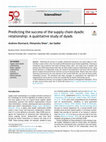
IIMB Management Review, 2023
The existing supply chain dyadic relationship (SCDR) measurement tools overly focus on a narrow g... more The existing supply chain dyadic relationship (SCDR) measurement tools overly focus on a narrow group of relationship elements in a fully developed business-to-business dyadic relationship. Predicting dyadic relationship success at the very early stage of relationship development is quite critical as the existing SCDR elements have limited capabilities. Drawing on transaction cost economics and social exchange theory, this study aims to explore and enhance the SCDR measurement tools that can likely predict putative relationship success. Using mixed methods in a longitudinal study, the research used qualitative interviews with an expert panel of supply chain practitioners, and then surveys of selected dyads. Results show that culture matching is perceived to be a key element in the revised SCDR tool that will likely predict the relationship success. The enhanced tool helps managers to comprehend the importance of organisational culture and its critical role in predicting the dyadic relationship success.
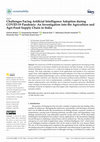
Sustainability, 2023
The coronavirus (COVID-19) pandemic has witnessed a significant loss for farming in India due to ... more The coronavirus (COVID-19) pandemic has witnessed a significant loss for farming in India due to restrictions on movement, limited social interactions and labor shortage. In this scenario, Artificial Intelligence (AI) could act as a catalyst for helping the farmers to continue with their farming. This study undertakes an analysis of the applications and benefits of AI in agri-food supply chain, while highlights the challenges facing the adoption of AI. Data were obtained from 543 farmers in Odisha (India) through a survey, and then interpreted using “Interpretive Structural Modelling (ISM)”; MICMAC; and “Step-Wise-Assessment and Ratio-Analysis (SWARA)”. Response time and accuracy level; lack of standardization; availability of support for big data; big data support; implementation costs; flexibility; lack of contextual awareness; job-losses; affordability issues; shortage of infrastructure; unwillingness of farmers; and AI safety-related issues are some challenges facing the AI adop...
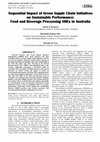
Operations and Supply Chain Management An International Journal, 2023
External Pressure and Green Human Resource Management (GHRM) drive green initiatives but their sy... more External Pressure and Green Human Resource Management (GHRM) drive green initiatives but their synergistic effects on Green Supply Chain Initiatives (GSCIs) are yet to be explored. Moreover, results of three elements of the triple bottom line sustainability show mixed relationship in the order they affect each other. Drawing on the Natural Resource-Based View (NRBV) and institutional theory, this research empirically investigates a theoretical model by examining: first, the impact of GHRM practices and external pressures on GSCIs; second, the impact of GSCIs on environmental performance; and third, their sequential effects on social and economic performance. Cross-sectional survey data from 168 SMEs in the Food and Beverage sector in Australia were analysed using structural equation modeling. Results reveal that GHRM practices and external pressures have positive effects on GSCIs that in turn affects sequentially on environmental, social and economic performance. Social dimensions, however, have no significant effect on economic performance. Meanwhile, GSCIs mediate the relationships between GHRM practices and external pressures and environmental performance. Implications are drawn.
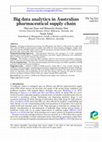
Industrial Management & Data Systems, 2023
PurposeDrawing on information processing view (IPV) theory, the objective of this study is to exp... more PurposeDrawing on information processing view (IPV) theory, the objective of this study is to explore big data analytics (BDA) in pharmaceutical supply chain (PSC) for better business intelligence. Supply chain operations reference (SCOR) model is used to identify and discuss the likely benefits of BDA adoption in five processes: plan, source, make, deliver and return.Design/methodology/approachSemi-structured interviews with managers in a triad comprising pharmaceutical manufacturers, wholesalers/distributors and public hospital pharmacies were undertaken. NVivo software was used for thematic data analysis.FindingsThe findings revealed that BDA capability would be more practical and helpful in planning, delivery and return processes within PSC. Sourcing and making processes are perceived to be less beneficial.Practical implicationsThe study informs managers about the strategic role of BDA capabilities in SCOR processes for improved business intelligence.Originality/valueAdoption of...

The Palgrave Handbook of Supply Chain Management, 2023
The Internet of Things (IoT) is a growing ubiquitous technology, powered with radio-frequency ide... more The Internet of Things (IoT) is a growing ubiquitous technology, powered with radio-frequency identification (RFID) tags embedded in devices with wireless, mobile, and sensor capability, which can capture and share data seamlessly in an information network. The scholarly and practice fields of IoT has been growing rapidly and is indicative of this technology's maturity. Its applications are widespread with enormous potential for future deployment across industry sectors. To understand the development of IoT in supply chain management, this chapter reviews IoT for digital transformation (SCM 4.0) within Industry 4.0. We put forth some technological and business challenges facing the adoption decision. This chapter summarizes the latest development of IoT applications and trends, and identifies other disruptive technologies that can complement IoT and supply chain management amid technological and business challenges. Areas of future concerns and directions are also presented.
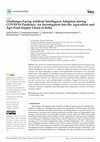
Sustainability , 2023
The coronavirus (COVID-19) pandemic has witnessed a significant loss for farming in India due to ... more The coronavirus (COVID-19) pandemic has witnessed a significant loss for farming in India due to restrictions on movement, limited social interactions and labor shortage. In this scenario, Artificial Intelligence (AI) could act as a catalyst for helping the farmers to continue with their
farming. This study undertakes an analysis of the applications and benefits of AI in agri-food supply chain, while highlights the challenges facing the adoption of AI. Data were obtained from 543 farmers in Odisha (India) through a survey, and then interpreted using “Interpretive Structural
Modelling (ISM)”; MICMAC; and “Step-Wise-Assessment and Ratio-Analysis (SWARA)”. Response time and accuracy level; lack of standardization; availability of support for big data; big data support; implementation costs; flexibility; lack of contextual awareness; job-losses; affordability issues; shortage of infrastructure; unwillingness of farmers; and AI safety-related issues are some challenges facing the AI adoption in agri-food supply chain. Implications were drawn for farmers
and policy makers.
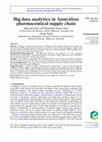
Industrial Management & Data Systems, 2023
Purpose-Drawing on information processing view (IPV) theory, the objective of this study is to ex... more Purpose-Drawing on information processing view (IPV) theory, the objective of this study is to explore big data analytics (BDA) in pharmaceutical supply chain (PSC) for better business intelligence. Supply chain operations reference (SCOR) model is used to identify and discuss the likely benefits of BDA adoption in five processes: plan, source, make, deliver and return. Design/methodology/approach-Semi-structured interviews with managers in a triad comprising pharmaceutical manufacturers, wholesalers/distributors and public hospital pharmacies were undertaken. NVivo software was used for thematic data analysis. Findings-The findings revealed that BDA capability would be more practical and helpful in planning, delivery and return processes within PSC. Sourcing and making processes are perceived to be less beneficial. Practical implications-The study informs managers about the strategic role of BDA capabilities in SCOR processes for improved business intelligence. Originality/value-Adoption of BDA in SCOR processes within PSC is a step towards resolving the challenges of drug shortages, counterfeiting and inventory optimisation through timely decision. Despite its innumerable benefits of BDA, Australian PSC is far behind in BDA investment. The study advances the IPV theory by illustrating and strengthening the fact that data sharing and analytics can generate real-time business intelligence helping in better health care support through BDA-enabled PSC.









Uploads
Papers by Assoc Professor Himanshu Shee
modeling with a partial least square approach. The findings demonstrate the significant and positive influence of digital capability and orientation on SMEs’ digital transformation and innovation during the pandemic. Additionally, the study confirms that digital transformation and innovation positively affect SMEs’ performance during the pandemic. Furthermore, the study reveals that digital transformation and innovation mediate the relationship between digital orientation and capability on SMEs’
performance during the pandemic. However, digital innovation was not found to significantly mediate the link between digital capability and SMEs’ performance.
farming. This study undertakes an analysis of the applications and benefits of AI in agri-food supply chain, while highlights the challenges facing the adoption of AI. Data were obtained from 543 farmers in Odisha (India) through a survey, and then interpreted using “Interpretive Structural
Modelling (ISM)”; MICMAC; and “Step-Wise-Assessment and Ratio-Analysis (SWARA)”. Response time and accuracy level; lack of standardization; availability of support for big data; big data support; implementation costs; flexibility; lack of contextual awareness; job-losses; affordability issues; shortage of infrastructure; unwillingness of farmers; and AI safety-related issues are some challenges facing the AI adoption in agri-food supply chain. Implications were drawn for farmers
and policy makers.
modeling with a partial least square approach. The findings demonstrate the significant and positive influence of digital capability and orientation on SMEs’ digital transformation and innovation during the pandemic. Additionally, the study confirms that digital transformation and innovation positively affect SMEs’ performance during the pandemic. Furthermore, the study reveals that digital transformation and innovation mediate the relationship between digital orientation and capability on SMEs’
performance during the pandemic. However, digital innovation was not found to significantly mediate the link between digital capability and SMEs’ performance.
farming. This study undertakes an analysis of the applications and benefits of AI in agri-food supply chain, while highlights the challenges facing the adoption of AI. Data were obtained from 543 farmers in Odisha (India) through a survey, and then interpreted using “Interpretive Structural
Modelling (ISM)”; MICMAC; and “Step-Wise-Assessment and Ratio-Analysis (SWARA)”. Response time and accuracy level; lack of standardization; availability of support for big data; big data support; implementation costs; flexibility; lack of contextual awareness; job-losses; affordability issues; shortage of infrastructure; unwillingness of farmers; and AI safety-related issues are some challenges facing the AI adoption in agri-food supply chain. Implications were drawn for farmers
and policy makers.
processes in finance to manufacturing, retailing, healthcare, government, etc. This interest was partly triggered due to the paradigm shift in Industry 4.0 and SCM 4.0, where a plethora of technologies are set to be adopted, as they are deemed to fit into existing practices. For example, IoT, Robotics, AI/ML, 3D printing, and blockchain technologies are among the few have been adopted early, as a pilot, or picked up for selective use. Blockchain can offer many functionalities and capabilities, such as data
security, improved visibility in supply chain processes, and an enhanced accuracy and availability of information. However, the lack of understanding of business cases and their ability to integrate
into existing processes, along with their cost, benefits, and investment returns, has raised questions regarding how they could be scaled up in a supply chain for a better performance. There is concern regarding how to adopt this technology into current practices.
The supply chain has been identified as one of the non-financial areas (its application is not limited to financial transactions) where the ledger can be used for the storage, authentication and dissemination of transaction records throughout the supply chain. Once a copy of the transaction
is recorded, all other copies in a supply chain are updated in real-time, and are ideally immutable. As the supply chain needs close monitoring for optimal functioning at each nodal point, disparate systems can provide limited transparency and information visibility, leading to poor business
intelligence under uncertainty. Blockchain technology is perceived to address these pain points in logistics, document frauds, counterfeit medicines, food adulteration and other issues, irrespective of
industry. The COVID-19 pandemic context is an example, where goods, information and fund flows were disrupted due to the multiple restrictions. Authors argue that blockchain technology is ideal for reducing the threats of disruption arising from the COVID-19 pandemic.
This edited book aims to collate the thoughts of various authors, who have presented their state-of-the-art views on blockchain technology and its applications in various fields. The contributed papers help to develop an understanding of how blockchain technology can enhance the efficacy
of human activities during the pandemic, improve traceability and visibility in automotive supply chains, support food safety and reliability through the digitalisation of food supply chain and increase the performance of next-generation digital supply chains. The authors believe that digital
supply chains powered by blockchain technology develop resilience against disruption, and set the groundwork for a more sustainable performance. We hope that you will find this book interesting,
useful and exciting, as it broadens the understanding of the emerging blockchain technology and its applications in supply chains across industry sectors. This book could serve as a suitable reference
for academics, researchers, and practitioners in industry and consulting.